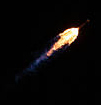The basic position in that these are pretty safe bits of kit if properly handled and cared for. One of the factors is that lithium-ion technology doesn't seem to scale up very well - so while there are large capacity units they are in essence comprised of many (maybe hundreds or even thousands) of smaller individual batteries connected together.
Lithium -ion batteries, if damaged can catch fire and burn fiercely, causing other adjacent cells to catch fire and then explode violently. Damage can be cause by poor handling, and overcharging. But spotting a damaged unit is very difficult. The risks of problem rise with the battery capacity as only one failure in a cell can destroy the whole battery and cause a fire which can spread quickly to anything surrounding it.
Fires are comparatively rare but on the increase - mainly because the growth in the use of these batteries is so large. If you have say an electric scooter or bike, the safest place to charge it would be out in the garden away from anything flammable. Not all can do that. It would be prudent not to leave a charging battery alone - and certainly not while asleep. And of course make sure your home insurance is up to date.
Some batteries have detection systems within them which aim to shut off charging if a problem develops, but how they help if the battery isn't being charged but has suffered physical damage I'm not so sure. On aeroplanes they now carry fireproof bags or boxes to contain an item should one start smouldering mid air.
All I can say is treat these items with respect. Even our mobile phones are problematic. I had two old iPhone 5 phones where the battery in both (which is in a strong plastic sealed enclosure) swelled up, bending the screen up away from the back housing. The phones were not damaged but they were old. .Replacement batteries fixed the problem, but then how do you dispose of a problematic lithium-ion battery safely.? Certainly not in your normal rubbish and not in the recycling bin.
Be aware of the issues and act accordingly.
Last edited by DebF_EONNext; 24-05-23 at 19:05. Reason: removed featured thread
Current Eon Next and EDF customer, ex Zog and Symbio. Don't think dual fuel saves money and don't like smart meters. Chronologically Gifted. If I offend let me know by private message, but I’ll continue to express my opinions nonetheless.





